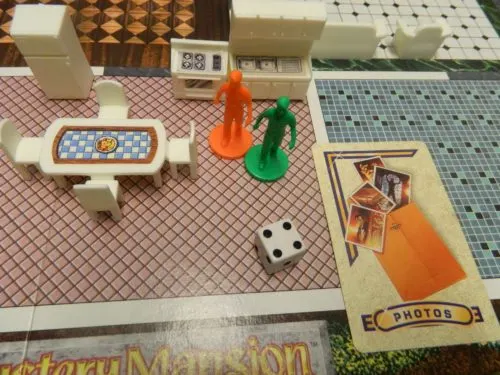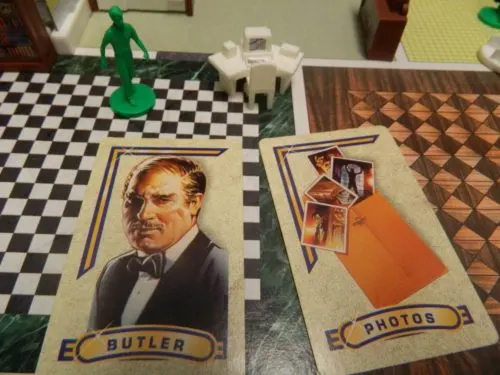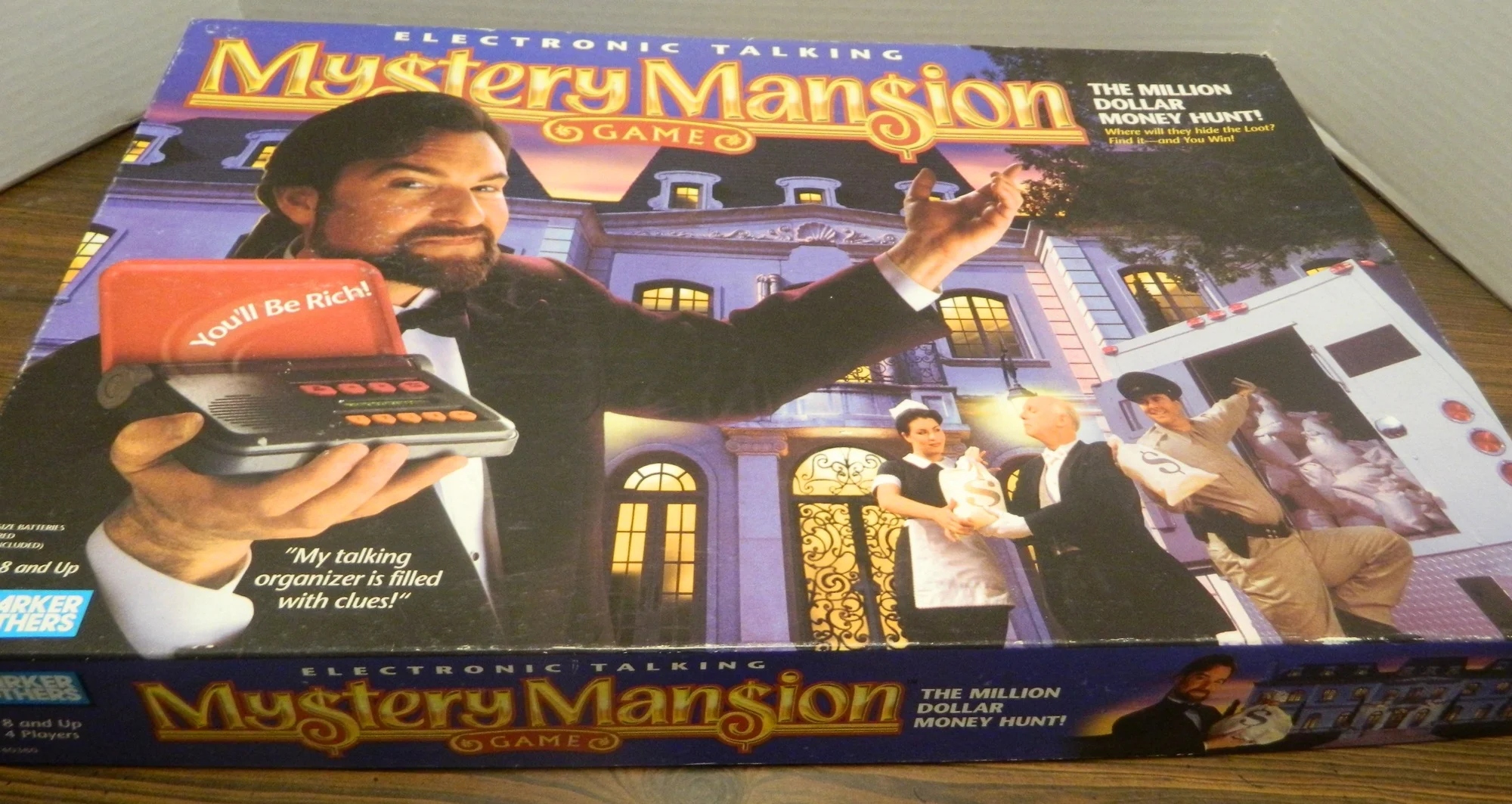How to Play
Setup
Separate the 10 “clue” cards and shuffle them placing them face down on the table. If you are going to use the “turn” cards sort them by the words on the cards and place them face up on the table. Place all of the furniture to one side of the table. Each player chooses a different colored playing piece and places them in the room inside the front door. Press the on button on the organizer to start the game. Pick a player to go first and play will then continue in a clockwise manner.
Player’s Actions
Each player gets to perform three actions on their turn. There are three different actions that a player can perform and the player chooses which actions they want to perform and in what order they want to perform them. A player could do the same action three times, one action twice and one action once, or the player can do each action once. The game has included the turn cards which you can use to indicate which actions you performed on a given turn. The three actions a player can perform are as follows:
Move
The move action allows a player to move to an adjacent room. Each room that a player moves to counts as an action.
If a player is the first player to enter a room, the player enters the room’s code into the electronic unit. The electronic unit will then describe the room and tell you what furniture to put into the room. Putting the furniture into the room does not count as an action.

The green player was the first player to enter this room so they input the room’s code into the electronic device. The device tells the player which pieces of furniture to put into the room.
If a player tries to enter a locked room, the electronic unit will ask for a key card. If the player who is trying to enter the room has a key card they show it to the other players and press the yes button on the electronic unit. This will unlock the door for the rest of the game. The player gets to keep the key card in their hand. If the player does not have a key card, they press the no button and are unable to enter the room. This will still count as an action since you tried to enter the room.

The orange player has tried to enter a locked room. If they have a key card they are able to enter the room.
Look
A player can use one of their actions to look at one of the pieces of furniture in the room that they are currently in. The player enters the number on the piece of furniture into the electronic device.

This player has decided to check the sofa. They would input the number 121 (found on the seat) into the organizer and follow what the organizer says.
The electronic device will then tell the players what was found:
- The game will usually give clues out loud for all of the players to hear. Make sure to make notes of these clues.
- Beeping Sound: This means that the clue is a private message that will be shown on the electronic unit’s screen. Only the player who searched the piece of furniture will get to see the clue.
- The electronic unit will occasionally ask for certain cards. If the player has the card they show it to the other players and then press the “yes” button. If they don’t have the clue card you press the “no” button.
- “You Have Found A Clue”: Take the top clue card from the pile on the table. This message will be repeated twice for the piece of furniture and then the piece of furniture will give no additional clue cards.
- “Take a Clue From Another Player”: You get to take one card of your choice from another player.
Let’s Talk
If a player wants to steal a card from another player they can challenge them. The current player chooses which player they would like to challenge. Both players roll the die and whoever rolls a higher number wins the challenge (ties go to the player who was challenged). If the current player wins the challenge they get to take any one card of their choice from the player. If the challenged player wins, the current player doesn’t take any cards from them.

The challenging player was able to roll higher than the challenged player and was able to take the photos card.
Winning the Game
The game continues until someone finds the piece of furniture that the treasure is hidden in and has the appropriate cards to retrieve it. When this is accomplished the electronic unit will declare the current player as the winner of the game.

The green player has searched the computer and had the two cards that the electronic organizer requested. The electronic organizer declares the green player as the winner.
Review
A while back we took a look at the 1984 game Mystery Mansion. Mystery Mansion was a decent game with some interesting ideas but it relied heavily on luck which kept it from being anything more than an average game. Mystery Mansion was a semi-popular game so when the electronic games craze began in the 1990s, Parker Brothers decided to update the game to include an electronic component.
Being a remake you would assume that the two games would share a lot in common. Both games have a similar premise where players move through a house looking for clues which will guide them to a hidden treasure. In both games players search furniture in order to find clues which will lead them to the treasure.
Despite sharing the same name and a similar premise, the two Mystery Mansions are actually considerably different. The original Mystery Mansion plays more like a typical roll and move game while the newer electronic version plays more like a deduction game. In the original game you played cards to search furniture and hoped to find a treasure chest card. In the newer version you use clues to lead you to the piece of furniture that holds the treasure.
Like its’ predecessor, Electronic Talking Mystery Mansion is a simple game to learn and play. The rules take a couple minutes to read and explain to new players. While Electronic Talking Mystery Mansion is not particularly deep, I had fun playing the game. It is far from a strategic deduction game as I will get to soon but you can have fun with the game if you realize that it is just a casual game where you shouldn’t put too much thought into your moves.
One of the best parts of Electronic Talking Mystery Mansion are the components.
- The electronic component is simple to use and works well for the most part.
- If you are a fan of 3D board games you are going to love the furniture included with the game. The furniture actually looks really nice and I give Parker Brothers credit since they could have easily just used cards or a list of codes and reduced the cost of the game significantly. The idea of the numbers printed on the furniture could have used some work though since the numbers are very small and are sometimes printed in strange places which makes it sometimes hard to actually read and find them. If you have bad eyesight you are going to need to use the provided magnifying glass in order to read the numbers.
- I like how the game has included male and female playing pieces for all of the colors. A lot of games mostly include just male playing pieces so it is nice to see a game from the 1990’s being inclusive and letting players use what piece they would like to use.
- I personally think the action cards are pointless. I don’t know why anyone would use them since is it really that hard to remember how many actions you have taken on your turn?
- While the components for the game are nice, the game comes in a huge box. The box has so much wasted space that it could have been made quite a bit smaller if they would have put one more fold into the gameboard.
So while Electronic Talking Mystery Mansion is a somewhat fun game with good components, the game has some issues.
I have to make a few comments on the theming of the game. The designers deserve credit for making an effort but at times the theme is just ridiculous. So Mr. B. Emmet Redstone’s an eccentric millionaire that invites people over to his house and gives them clues on where to find his money? Kind of odd but maybe he is a generous man that wants to give away his money. I can’t understand his choices of hiding spots though. Mr. Redstone has some brilliant hiding places including the hot tub, treadmill, telescope, computer, fish tank, and easel. I don’t even know how you could hide money in some of those items. By far the dumbest location though is the fireplace. Either no one ever uses this house or Mr. Redstone’s money will burn up any time the fireplace is used. Add in the fact that you need some random clue and permission of one of his employees to collect the money? You are probably better off not really thinking about the theme of Electronic Talking Mystery Mansion.
While the Electronic Mystery Mansion game seems like a deduction game, it doesn’t really play like one. This is because there are way too few secret clues. Probably at least 75% of the clues are given to all of the players at the same time. None of these clues are that helpful since everyone will know the information which puts all of the players on an even footing. There are so few secret clues that if you end up finding one of the pieces of furniture that have a secret clue you can get a pretty big advantage over the other players.
You can never really gain too big of advantage over the other players because it is really hard to hide that you actually know what piece of furniture has the hidden treasure. This is because all of the players hear when you search a piece of furniture and it asks for two different clue cards. There are only a couple pieces of furniture that ask for two clues in the entire game so if you end up hearing the game asking for a second clue card you have a good idea where the treasure could be hiding.
So this brings me to how Electronic Talking Mystery Mansion usually ends. Basically the game revolves around controlling the clue cards. Whoever can control the most clue cards will likely win the game. Since you need the correct clue cards to eventually get the treasure, whoever controls those cards will likely win the game. This creates a war for the cards at the end of the game where all of the players are fighting for control over the cards. The cards are all of the power in the game.
Now this might not have been such a bad idea if it wasn’t for the fact that control over the cards is solely determined by luck. You can get cards in three different ways.
- You randomly choose to search a piece of furniture that gives you a card. If you are able to do this and still have an action available you likely are going to search the same piece of furniture in order to take another clue card.
- You can search a piece of furniture that lets you take a clue card from another player.
- You can “talk” to another player and steal one of their cards if you can roll a higher number than they can.
So there are a couple of ways to get the clue cards but every single one of them relies on luck. You have no idea what furniture will give you clue cards. Unless you are an expert dice roller, determining the outcome based on a die roll will always come down to luck. Since everyone will pretty much figure out where the treasure is hidden at the same time, it becomes a race to whoever has or can get the necessary cards first. This means that the luckiest player will almost always win the game. For example in the game I played one player was able to win almost every “talk” action and this player ended up controlling almost all of the clue cards. It should not come as a surprise that this player ended up winning the game.
The problem is that it could be kind of difficult to create a house rule that would fix these problems. The best option would probably be to allow a player to only attempt to steal one card from each player. You could also implement a rule that you could only steal cards from players that you are in the same room as. Both of these will prevent players from continuing to steal all of the clue cards. The problem is that these rules will probably prolong the game as players will just steal the cards from each other and you will get a never ending loop until someone rolls considerably better than the other players.
Final Verdict
Overall I would say that Electronic Talking Mystery Mansion is a pretty average game. The components are really nice and the game has some interesting mechanics. The game is fun if you don’t put too much thought into it. The problem is that there really isn’t much deduction in the game. Since there is so much public information all of the players are probably going to figure out the treasures’ location at the same time. This means it comes down to luck as to who will be lucky enough to get the right clue cards in order to claim the treasure.
I would classify Electronic Talking Mystery Mansion as the type of game that I would play if someone else wanted to play but I don’t really see suggesting to play the game anytime soon. If you have fond memories of the game I think you will still enjoy it. If you are looking for a good deduction game though, Electronic Talking Mystery Mansion is not going to be it. If you can find it for a good price and you don’t mind a lot of luck in games, it may be worth picking up.
If you would like to purchase Electronic Talking Mystery Mansion you can purchase it here.



Crisa
Thursday 24th of October 2019
Can you email the directions to me?
Eric Mortensen
Friday 25th of October 2019
The rules section of this review includes all of the rules that are required to play the game. If you want to print out a copy of the full rules though you can find them here on Hasbro's website.